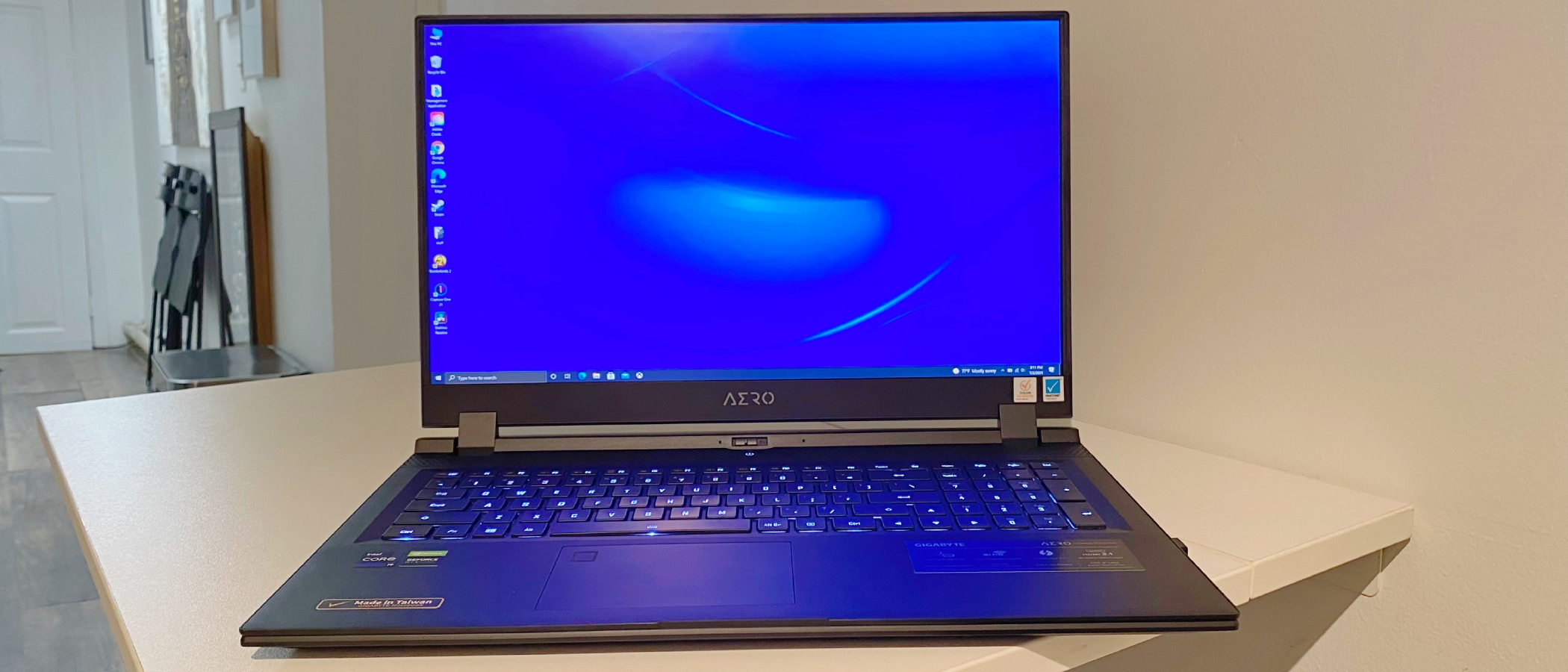Laptop Mag Verdict
The Gigabyte Aero 17 HDR is an excellent content-creating laptop, but some flaws that may cause shoppers to look elsewhere
Pros
- +
Fast performance
- +
Gorgeous 4K display with accurate colors
- +
Great keyboard
Cons
- -
Can get hot while gaming
- -
Poorly placed webcam
- -
Expensive
- -
Weak audio
Why you can trust Laptop Mag
Price: As reviewed $3,699
CPU: Intel Core i9-11980HK
GPU: Nvidia GeForce RTX 3080 with 16GB VRAM
RAM: 32GB
Storage: System 512GB, 1TB PCIe NVMe SSD
Display: 17.3-inch, UHD 4K
Battery: 4:34
Size: 15.6 x 10.6 x 0.8 inches
Weight: 5.5 pounds
There’s nothing I love more than laptops meant for creators because they’re all about performance and looking and sleek. The Aero 17 HDR YD is all of those glorious things but, be warned, it's a scorcher. Like a hot summer's day, the view on the 17-inch, 4K UHD display is beautiful, and the powerful specs will keep the hardest working creators moving. But its one flaw may make it too hot for some.
Gigabyte Aero 17 HDR YD pricing and configurations
Our review model costs $3,699 and comes with an Intel Core i9-11980HK CPU, 32GB of RAM, a 512GB HDD, a 1TB SSD, an Nvidia GeForce RTX 3080 GPU with 16GB of VRAM, and a 17.3-inch, 4K UHD IPS anti-glare display.
The Aero HDR comes in three options, with the mid-tier unit costing $3,649. It arrives with all the same specs as the top tier, except it has half the vRAM. The $2,499 base model comes with an Intel Core i7-11800H CPU, 16GB of RAM, a 1TB SSD, an Nvidia GeForce RTX 3070 GPU with 8GB of VRAM, and a 1TB of SSD.
Gigabyte Aero 17 HDR YD design
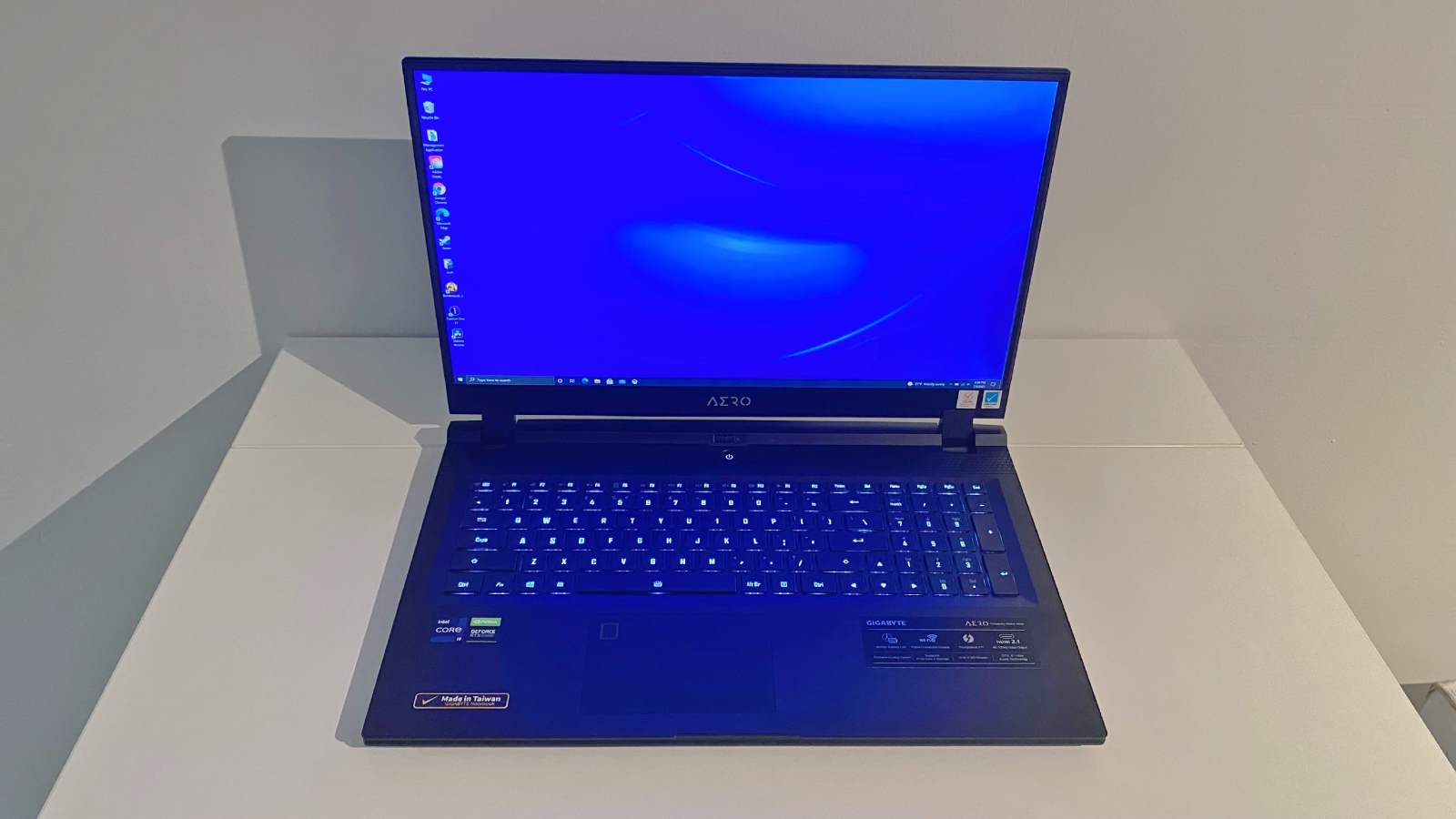
The all-black, all-metal CNC aluminum chassis on the Aero is sleek. When turned on, the Aero logo on the lid lights up and goes well with the chrome Aero insignia located between the rear vents. It adds to the attractive look of the carbon fiber at the bottom of the lid.

When opened, the beauty of the display welcomes you warmly with the blue Windows 10 background. The metal deck has a luxurious feel and the keyboard is sunk nicely into its center. The chiclet-style Gigabyte Fusion RGB per-key backlit black keyboard is very responsive. There are two speaker vents located on either side of the power button on the upper part of the deck.
The Aero 17 HDR YD measures 15.6 x 10.6 x 0.8 inches and weighs 5.5 pounds. The Aero is the lightest of its competitor group, followed by the Razer Blade Pro 17 (6.1 pounds, 15.5 x 10.2 x 0.8 inches) and the Alienware m17 R4 (6.6 pounds,15.7 x 11.6 x 0.9 inches). The beast of our group is the Origin EON 17-X, which tips the scales at 8.34 pounds and measures 15.7 x 12.5 x 1.7 inches.
Sign up to receive The Snapshot, a free special dispatch from Laptop Mag, in your inbox.
Gigabyte Aero 17 HDR YD security

The Aero 17 HDR comes with a fingerprint scanner to provide security for your data and files. Located on the upper left of the touchpad, it functions excellently and quickly gets you back to work. The unit also comes with a physical shutter for the webcam to keep people out when you’re done with your Google Meets and Zoom meetings. Located on the top center of the deck, the webcam’s physical shutter is easily switched from open to close and you can hear an audible click when you move it over.
Gigabyte Aero 17 HDR YD ports
The Gigabyte Aero 17 HDR YD comes with a good amount of ports to get you connected to all your favorite peripherals. On the right, you have a USB Type-A port, a USB Type-C port, one mini Displayport, an HDMI port, and the DC power port.
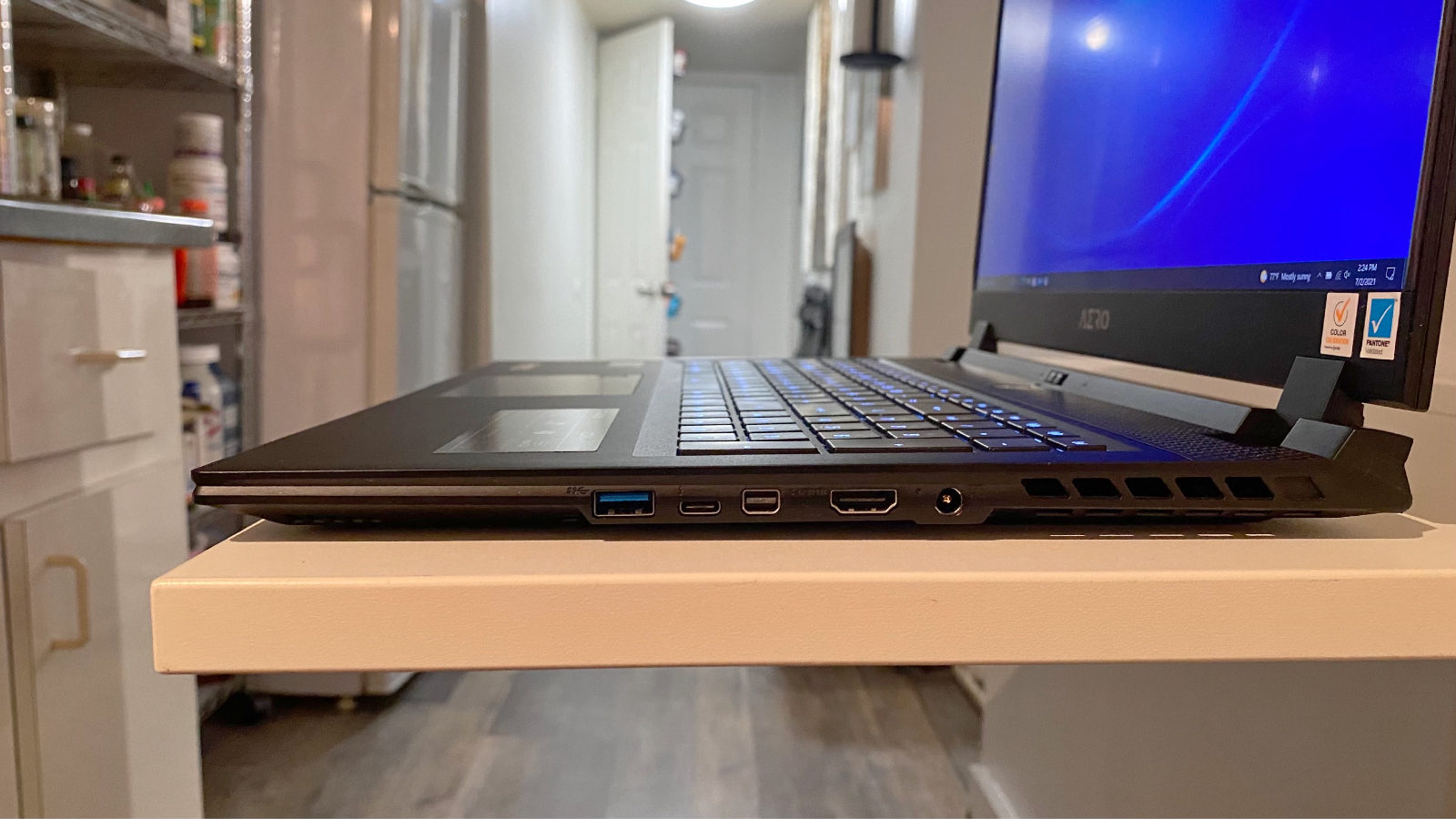
We find another two USB Type-A ports, an SD card reader, separate headphone and mic jacks, and an Ethernet port on the left side.

Gigabyte Aero 17 HDR YD display
The Gigabyte Aero’s 17.3-inch, 4K screen is X-Rite factory-calibrated and Pantone rated for color accuracy. Ensconced in an ultra-slim bezel, the panel is stunning, immersive and is a boon for creating or watching videos and playing games. It’s bright and clear, and the color saturation is beautiful.
OK, I’m still addicted to Borderlands 2; I have not finished the game, so don’t judge me too harshly. That said, the Aero 17 rendered the animation-styled game flawlessly, with bright, lusciously saturated colors that made gameplay fun and super immersive thanks in part to the sheer size of the display. At one point, I was caught with my back against a wall while being attacked by an armored maniac; I was out of ammo and had to gun butt him, and the splashes of bright deep red blood splattered all over the ground beneath. It looked amazingly garish and gory.
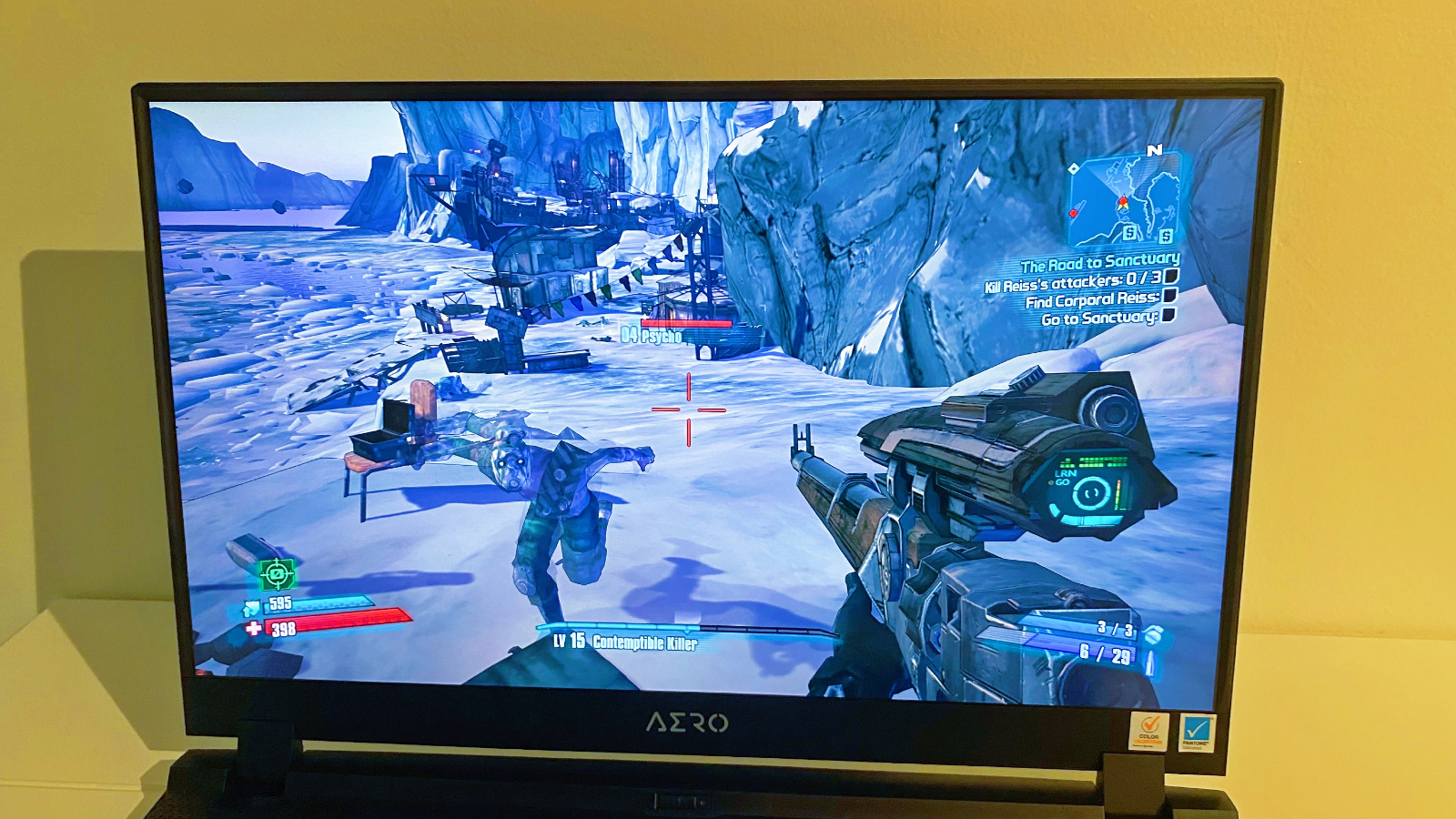
After satiating my blood lust, I moved on to watch the Top Gun Maverick trailer. In the scene where the fighter jet just barely dodges a missile, the explosion behind the plane looks fantastic. The clear blue sky was filled with yellow, orange, and black explosions with grey plumes of smoke.
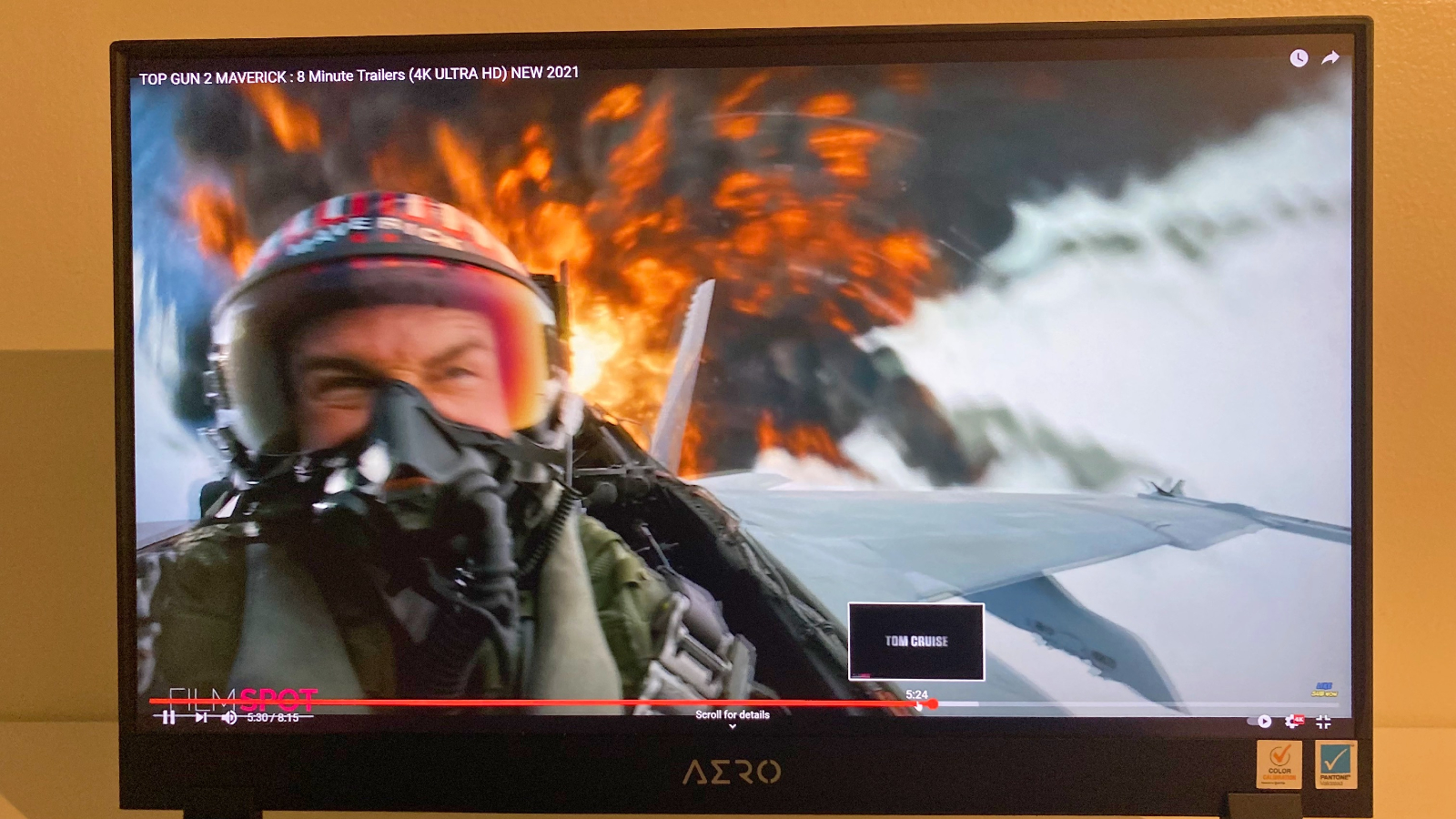
The Aero scored 76.9% of the DCI-P3 color gamut during our testing, which is below the 86.6% premium gaming laptop average. The Blade 17 Pro scored 84.1%, followed by the Alienware m 17 R4 with 80.6%. The Eon 17-X closed us out with a score of 78%.
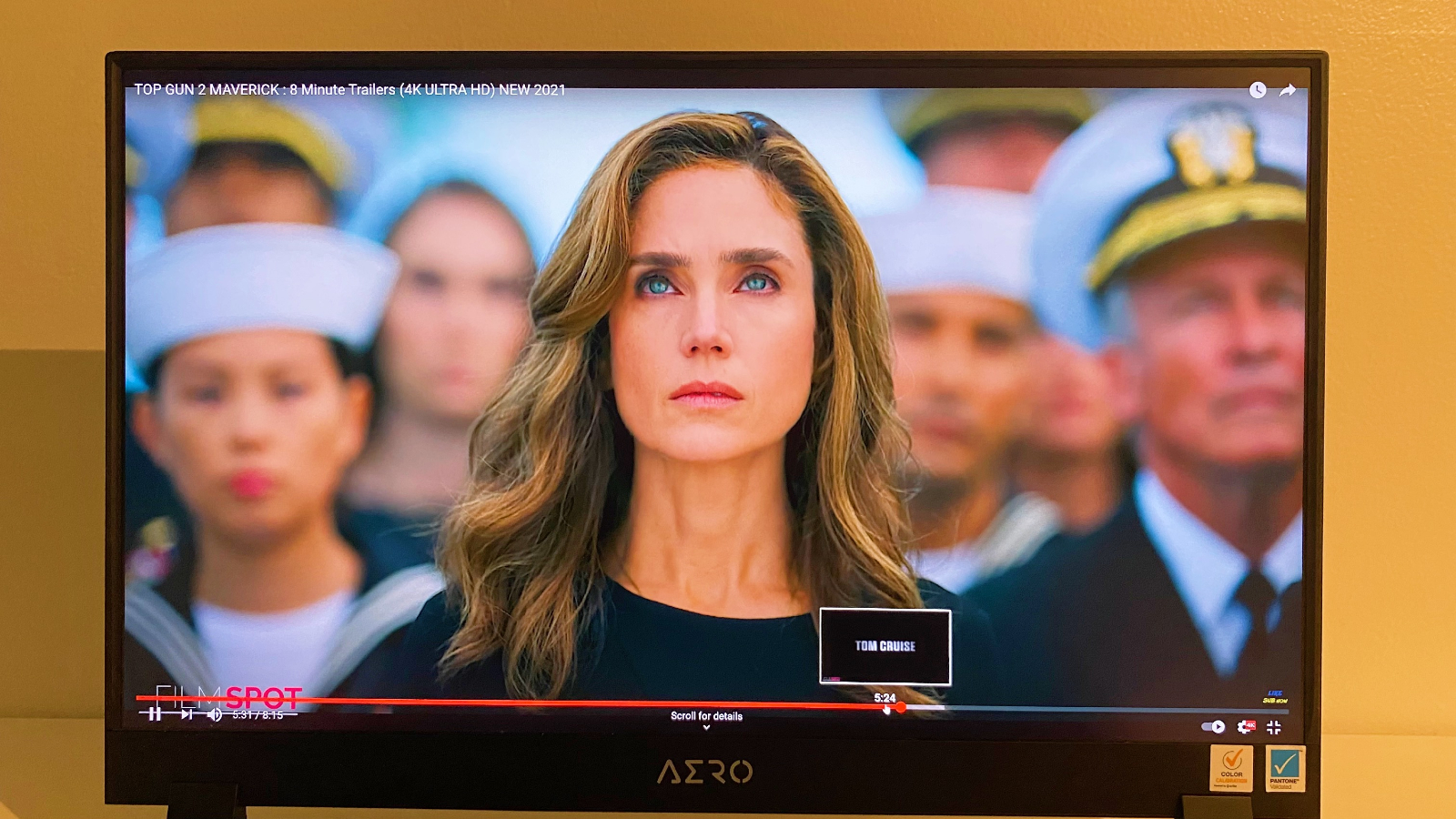
The Aero 17 HDR blew the competition away when it came to display brightness, scoring a fantastic 468 nits. That’s well above the 322-nit average for its genre. It was followed by the Alienware m17 R4 (316 nits), the Razer Blade 17 Pro (304 nits) and the Eon 17-X (251 nits).
Gigabyte Aero 17 HDR YD audio
The Gigabyte Aero 17 comes equipped with a pair of speakers located on the top of the deck which are fine-tuned with DTS-X Ultra software. The audio quality is fine for a laptop but lacks accurate bass and is void of thump. However, the speakers are loud and could be heard across my studio apartment.
The lack of bass made listening to Chris Brown’s “Look At Me Now” disappointing, but at least there was never any low-end distortion no matter how much bass I added via the DTS- X software.
After my lackluster listening session, I played another round of Borderlands 2; this was where I had the best audio experience. Thanks to the DTS-X spatial audio software, the sound was immersive, and I could hear creatures coming up on either side of me. Gunfire sounded nice, but a bit tinny, and explosions had more crackle than thunder. However, it was acceptable for solo listening as I just sat at my desk. To fully enjoy the audio experience of DTS-X, I suggest using a pair of headphones. In the case of gaming, I would check out our best gaming headsets of 2021 to select a pair.
Gigabyte Aero 17 HDR YD keyboard and touchpad
I like the Aero 17 HDR’s keyboard; it worked well with my huge hands. The black Chiclet-style keys on the Aero 17 HDR are RGB-backlit. The keyboard is super responsive, with each key delivering a clicky yet soft bounce. I took the 10fastfingers typing test and scored some of my best results ever. I typed at 89 words per minute with 92% accuracy, as the ample deck and keyboard are built for people with Hulk-like hands like mine.
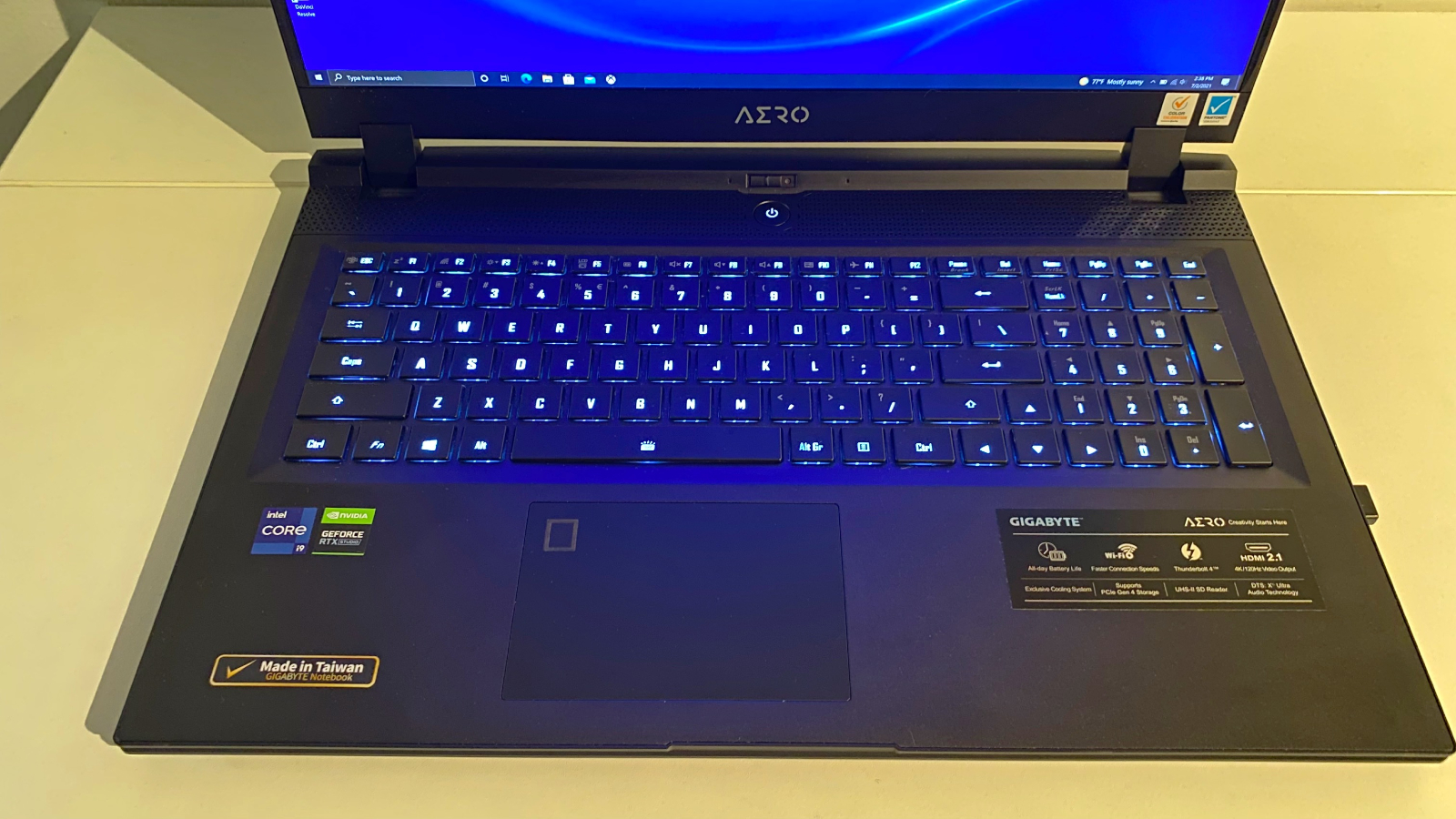
The 4.2 x 2.8-inch touchpad is responsive and accurate when navigating websites or documents. It performed all the Windows 10 gestures, such as two-finger swipes and three-finger taps, nicely. The bottom corners give substantial and clicky feedback when using either right or left clicks.
Gigabyte Aero 17 HDR YD graphics
The Aero 17 HDR comes with an Nvidia RTX GeForce 3080 GPU with 16GB of VRAM. We tested the Aero’s gaming chops by playing the Far Cry New Dawn benchmark in 1080p, and our unit delivered 101 frames per second. That blew past the 89-fps premium gaming laptop average. The Eon 17-X, with its Nvidia RTX GeForce 3080 GPU, scored 126 fps, followed by the Alienware m17 R4 and its Nvidia RTX 3080, which reached 105 fps. The Blade Pro 17 comes with an Nvidia GeForce RTX 2070 Super Max Q GPU and it rounded out our group with a score of 87 fps.
The Aero 17 improved slightly during the Grand Theft Auto V Benchmark with 111 fps, beating the 95-fps average and the Blade 17 Pro’s 89 fps. However, it couldn’t overtake either the Eon 17-X’s 131 fps or the Alienware m17 R4’s 120 fps.
Finally, when we ran the Red Dead Redemption 2 benchmark, the Aero 17 HDR scored 69 fps, just past the 61-fps average for second place. The Eon 17-X led our group with 88 fps, with the Razer Blade Pro 17 scoring 57 fps and the Alienware m17 scoring way below average at 39 fps.
In Assassin’s Creed Odyssey (1080p), the Aero 17 HDR hit 72 fps, surpassing the 65 fps average. The EON 17-X led our group with 83 fps followed by the Alienware m17 with 78 fps and the Razer Blade Pro closing things out at 63 fps.
When we played Shadow of Tomb Raider at 1080p, the Aero 17 HDR scored 78 fps, just beneath the average of 81 fps. Once again, the Eon 17-X led our group with a score of 117 fps with the Alienware m17 coming in second with a score of 103 fps, followed by the Blade Pro with 75 fps.
We closed out our gaming tests with Borderlands 3; our Aero 17 HDR scored 77 fps, which is above the 75 fps average. The leader, once again, was the Eon 17-X with 108 fps followed by the Alienware m17 at 102 fps and the Razer Blade Pro at 71 fps.
Gigabyte Aero 17 HDR YD performance
With an Intel Core i9-11980HK CPU and 32GB of RAM, the Aero 17 HDR is built for content creators and can handle demanding workloads just fine.
I shot 6K video and cracked open DaVinci Resolve, then effortlessly edited about 24 minutes of video before down-rendering it in 4K. There wasn’t any freezing or stuttering while operating DaVinci, and my workflow was speedily handled. The Aero 17 HDR performance while using the GPU-heavy app was impressive.

I then wanted to see how the system ran using Adobe, a more CPU-intensive app. In short, the performance was outstanding. I edited the 4K content I had previously shot and color graded with Resolve then added some effects using Adobe After Effects. The Aero 17 HDR impressed me again; it would be an excellent laptop to use while working on a mobile production.
I opened 50 tabs in Google Chrome with several playing YouTube videos and one streaming Loki on Disney+. The Aero must have thought I was joking and ignored my wasted attempts at bogging it down. However, I suggest using the Aero on a desktop surface as it got pretty hot on my lap after about 10 minutes.
During our Geekbench 5.4 synthetic overall performance test, the Aero 17 HDR scored 9,484surpassing the premium gaming laptop average of 7,006. It was only passed by the Origin Eon 17-X Intel Core i9-11900K which tallied 10,575. In the third position was the Alienware m17 Intel Core i9-10980HK with 8,082 followed by the Razer Blade Pro 17 Intel Core i7-10875H with a score of 5,989.
During the Handbrake video-editing test, the Aero 17 HDR performed well, taking 5 minutes and 59 seconds to transcode a 4K video to 1080p, beating the average score of 7 minutes and 48 seconds. The Eon 17-X (Intel Core i9-11900K) led our group with a score of 5:27, followed by the Alienware m17 R4 (Intel Core i9 10980HK), which did the job in 6:44. The Razer Blade Pro 17 (Intel Core i7 10875H) closed us out with a score of 9:31.
On our File Transfer test, the Aero 17 HDR (512GB System SDD 1TB storage SSD) delivered a transfer rate of 1,729 megabytes per second when duplicating 25GB of mixed-media files. It led our group and surpassed the 1,229.7 MBps average of 885.54. The Eon 17-X (1TB SSD) came in second at 1,288.48 MBps, followed by the Blade Pro 17 (512GB SSD) at 925.14 MBps, while the Alienware m17 R4 (dual 1TB SSD) closed us out with 448.5 MBps.
Gigabyte Aero 17 HDR YD battery life
Gaming laptops tend to have a poor battery life, so keep that in mind if you’re considering using one as a workstation. At 4 hours and 34 minutes on the Laptop Mag battery test, the Aero 17 HDR came in second within our comparison group. The laptop outlasted the 4:29 premium gaming laptop average and best the Eon 17-X and Alienware m17 R4, which clocked in a 2:07 and 2:05, respectively, The Blade Pro 17 was the last laptop standing at 4:41.
Gigabyte Aero 17 HDR YD heat
The Gigabyte Aero 17 HDR scored solidly during our independent heat test, which consists of running a fullscreen HD video for 15 minutes. The touchpad measured 78 degrees Fahrenheit, while the space between the G and H keys measured 88 degrees. The bottom of the laptop reached 114 degrees, which is above the 95-degree comfort threshold.
Those were the non-gaming scores. During our gaming tests (15 minutes of playing games), the touchpad and keyboard temps were slightly warmer at 78 and 89 degrees, respectively. But the underside hit a blazing temp of 136 degrees, which I noticed when I made the mistake of playing a video game with the unit lying on my chest.
Gigabyte Aero 17 HDR YD webcam
The Aero comes with your standard HD 720p webcam. It delivered sharp images, color-accurate video, and even skin tones when the lighting in the room was sufficient. I’m not a fan of the webcam’s location on the deck, centered between the hinges. It forces you to look down and gives whoever you’re chatting with a direct view of your neck and nostrils. I hope Gigabyte rectifies this in the next iteration of the unit.
The camera’s autofocus was accurate and quick, finding my face and following it when I moved around the frame. I cannot stress the importance of good lighting to get the best performance out of the camera. If your room isn’t well-lit, go with an external webcam for the best photo and video quality.
Gigabyte Aero 17 HDR YD software and warranty
The Aero 17 HDR YD comes with limited bloatware. You will find the DTS-X audio tuning software and not much else. Like every Windows 10 computer, there are apps for Skype, Office 365, Microsoft Solitaire suite, and Xbox console.
The Gigabyte Aero 17 HDR comes with a three-year warranty and you get 24/7 online support with the standard warranty.
Bottom line
The Gigabyte Aero 17 HDR YD ticks off all the essential boxes of what a creative professional needs in a mobile production laptop. It’s not too heavy, and the 17.3-inch, 4K display is vivid and color accurate, allowing for excellent color grading results. The powerful Intel Core i9 CPU bundled with the Nvidia GeForce RTX 3080 GPU can handle your video and image editing needs without batting an eyelash. However, the Aero 17 HDR is expensive, with so-so audio and can get hot when gaming. And while it’s no worse than the competition, the battery life will have you searching for a power outlet.
If more power is what you desire, you’ll want to take a look at the Origin Eon 17-X. However, keep in mind at $2,945, it’s seriously expensive and has an even shorter battery life. That said, the Gigabyte Aero 17 HDR YD is still one of the better c options for content creators.
Gigabyte Aero 17 HDR Specs
| Bluetooth | Bluetooth 5.0 |
| Brand | Gigabyte |
| CPU | Intel Core i9-9980HK processor |
| Display Size | 17.3 |
| Graphics Card | Nvidia GeForce RTX 2070 Max-Q GPU |
| Hard Drive Size | 512GB |
| Hard Drive Type | PCIe m.2 SSD |
| Highest Available Resolution | 3840 x 2160 |
| Native Resolution | 3840 x 2160 |
| Operating System | Windows 10 Pro |
| RAM | 16GB |
| Size | 15.6 x 10.6 x 0.8 inches |
| Touchpad Size | 4.1 x 2.7-inch |
| Video Memory | 8GB |
| Weight | 5.8 pounds |
| Wi-Fi Model | Killer Wi-Fi 6 AX1650x |

Mark has spent 20 years headlining comedy shows around the country and made appearances on ABC, MTV, Comedy Central, Howard Stern, Food Network, and Sirius XM Radio. He has written about every topic imaginable, from dating, family, politics, social issues, and tech. He wrote his first tech articles for the now-defunct Dads On Tech 10 years ago, and his passion for combining humor and tech has grown under the tutelage of the Laptop Mag team. His penchant for tearing things down and rebuilding them did not make Mark popular at home, however, when he got his hands on the legendary Commodore 64, his passion for all things tech deepened. These days, when he is not filming, editing footage, tinkering with cameras and laptops, or on stage, he can be found at his desk snacking, writing about everything tech, new jokes, or scripts he dreams of filming.
